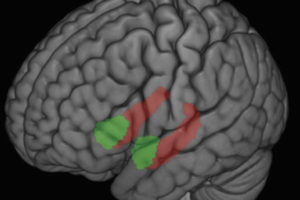In what may be the first study to use brain imaging to look at the neural circuits involved in emotional control in patients with depression, researchers at the University of Wisconsin—Madison have found that brains of people with clinical depression react very differently than those of healthy people when trying to cope with negative situations.
The study appears in the August 15 issue of the Journal of Neuroscience.
According to the World Health Organization, clinical depression is one of the leading causes of disability and lost productivity in the world. Understanding the root cause of depression, however, has proved difficult.
"It’s normal for people to have negative emotions in certain circumstances," says lead study author Tom Johnstone. "One of the features of major depression is not that people have negative reactions to negative situations, it’s that they can’t pull themselves out of those negative emotional moods. They seem to have a deficit in their ability to be able to regulate their emotions — to come back down to baseline after a negative experience."
To evaluate the role of emotional regulation in depression, psychology and psychiatry researchers from the UW–Madison School of Medicine and Public Health and Waisman Center monitored the brain responses of healthy or depressed individuals to a series of images designed to provoke strong negative emotional responses – images such as car accidents and threatening-looking animals.
Participants were asked to consciously work to decrease their emotional responses to some of the negative images, using techniques such as envisioning a more positive outcome than the one implied or by imagining the situation was acted out rather than real.
"We ask them to reframe the content of what they’re seeing," rather than divert their attention or distract themselves with unrelated thoughts, Johnstone says. "We hope to engage cognitive areas in re-interpreting the emotional content of a stimulus — to either increase or decrease its impact."
In both healthy and depressed individuals, they found that such efforts increased brain activity in prefrontal cortical areas known to help regulate the emotional centers of the brain, as they expected.
The big difference was seen in the reactions of the emotional centers themselves, including a small almond-shaped structure called the amygdala located deep in the brain.
In nondepressed individuals, high levels of regulatory activity correlated with low activity in the emotional response centers – in effect, the healthy subjects’ efforts successfully quelled their emotional responses. In depressed patients, however, high levels of activity in the amygdala and other emotional centers persisted despite intense activity in the regulatory regions.
This finding suggests that healthy people are able to effectively regulate their negative emotions through conscious effort, but that the necessary neural circuits are dysfunctional in many patients with depression, the researchers say.
The difference becomes even more pronounced the harder the patients try.
"Those [healthy] individuals putting more cognitive effort into it are getting a bigger payoff in terms of decreasing activation in these emotional centers," Johnstone explains. "In the depressed individuals, you find the exact opposite relationship – it seems the more effort they put in, the more activation there is in the amygdala."
"If we understand where the brain circuits are that are important and how they are involved in regulating emotion, then we can target them with different types of therapies."
Though the researchers don’t yet know exactly where the differences lie, Johnstone suggests multiple factors may be at work. One possibility is that depressed individuals have a broken link between the brain regions, such that regulatory centers fail to send any dampening signals to emotional centers.
Alternately, he says, depressed patients may fall prey to rumination on negative thoughts. Maybe, he says, "When they try to engage in this regulation they just think more about the emotional content of the images. Perhaps it’s quite maladaptive for them; instead of turning down their emotional responses possibly they turn up their emotional responses."
The results of this study may help identify appropriate treatment methods for people with depression, who represent a diverse patient population, says senior study author Richard Davidson.
Common psychological therapies use mental strategies similar to those used in this study, he says, and although psychotherapy might benefit patients who found conscious efforts effective in the scenarios provided in this study, it could be counterproductive for those patients whose mental efforts increased their emotional responses.
"Our results suggest that there is a subgroup of patients with depression for whom traditional cognitive therapy may be contraindicated," Davidson says. "Other therapeutic interventions may benefit this subgroup more than cognitive therapy, though this remains to be studied in future research."
Identifying the involvement of emotional brain circuits may also help focus the development of new treatment strategies for depression and other psychiatric disorders. "Emotional regulation underlies many psychiatric disorders, not only depression," Johnstone says.
Long term, he says, "If we understand where the brain circuits are that are important and how they are involved in regulating emotion, then we can target them with different types of therapies."
Other authors on the study include Carien van Reekum, Heather Urry, and Ned Kalin. The work was funded by grants from the National Institute of Mental Health and Wyeth-Ayerst Pharmaceuticals.
– Jill Sakai






